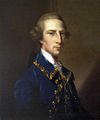John Astley (painter) facts for kids
John Astley (born June 24, 1724 – died November 14, 1787) was an English portrait painter and also an amateur architect. He was known for being popular among fashionable people and for becoming wealthy through his marriages.
Contents
Early life
John Astley was born in Wem, Shropshire, England. His father, Richard Astley (1671–1754), was an apothecary (a type of pharmacist). His mother was Margaret (1685–1735). He had a brother named Richard, who was also a doctor, and John inherited his brother's property.
Because he was considered very handsome, people called him Beau Astley. Some people also knew him as Jack Astley.
Career as a painter
In the 1740s, John Astley studied art in London with Joshua Reynolds under the artist Thomas Hudson. Later, in 1747, he traveled to Rome and Florence to continue his studies. One of his teachers there was Pompeo Batoni. After his studies, he started his career in Dublin, Ireland, for several years before settling in England.
People said that his best paintings were copies of famous works, like the Bentivolios and Titian's Venus. Some believed his success came more from his good luck than from his hard work as an artist. They also said he cared more about making money than about his art. However, he did have students, including the engraver John Keyse Sherwin. Another artist, Charles Hoyland, copied Astley's style.
Samuel Redgrave, who wrote a dictionary of English artists in 1878, said that Astley "had much talent, particularly in portraits." He noted that Astley used pleasant colors and had original ideas for his compositions, but his finished paintings sometimes lacked strong character or expression.
Horace Walpole, a writer and art collector, visited one of Astley's art shows in 1752. He mentioned that Astley had painted many people he knew. Walpole also joked that Astley was "so intolerable as to work for money, not for fame," meaning he focused on earning money rather than just becoming famous.
Some of the people John Astley painted included:
- the artist Sir Joshua Reynolds
- architect Benjamin Latrobe
- Lady Dukinfield Daniel, who later became his second wife
- Sir Horace Mann
- Marcus Beresford, 1st Earl of Tyrone, his wife, and daughter (in a group portrait)
- Peter John Fremeaux
- Sir Capel Molyneux and his children (in a group portrait from 1758, now at the Ulster Museum in Belfast)
- Rev. Thomas Alleyne of All Saints Church, Loughborough
- Mary Woodyeare
- Mary Weston (a portrait thought to be by Astley)
- Colonel Thomas Pepper (now at the Trinity Art Research Center)
- Alexander MacDonnell, 5th Earl of Antrim
Astley also painted a portrait of William Shakespeare. In 1787, the European Magazine reported that the artist Gilbert Stuart thought Astley's Shakespeare portrait was much better than another famous one owned by the Duke of Chandos.
Some people thought Astley stopped painting after his second marriage in 1759 because his wife was very wealthy. However, other reports from that time show he continued to paint. One account said he painted "for fun" even after becoming rich. Another source mentioned that he still took on painting jobs and charged a high price of "20 guineas" for his work.
Career as an amateur architect
John Astley was also known for changing and improving several buildings. One of these was Schomberg House in Pall Mall, which he owned and used as his home in London. This house was originally built for the third Duke of Schomberg.
Astley was very good at designing and decorating smaller buildings. Besides Schomberg House, he also worked on Lady Archer's saloon and conservatory in Barnes. His work on Dukinfield Lodge was considered even better. He finished Dukinfield Lodge in 1775. One special part of this house was an octagon-shaped room decorated with stained glass. This room also held some of the valuable art collection belonging to Astley and his son. A description from 1795 said that Dukinfield Lodge had "a fine octagon room with painted windows" and that many other rooms were "small, but elegant, and are decorated with pictures chiefly by the hand of Mr Astley."
Astley also remodeled Elm Bank, his house in Barnes. Later, in 1889, this house became the home and studio of the famous designer Christopher Dresser.
Marriages and family
John Astley was married three times.
His first wife was an Irish lady who sadly died while giving birth. They had a daughter named Sophia (1749–1831). Sophia later married Louis Foncier in 1792 and had children.
His second wife was Penelope Dukinfield Daniel (1722–1762). She was a widow and met Astley at an event in Knutsford. She was so impressed by him that she quickly arranged for him to paint her portrait, and they married soon after, on December 7, 1759, in Rosthern, Cheshire, England. She passed away in 1762. Through this marriage, Astley became the owner of the Dukinfield and Daniel estates, including Gorse Hall.
His third wife was Mary Wagstaffe (1760/1 – February 18, 1832), who was known as "a celebrated young beauty." She was the daughter of William Wagstaffe, a wealthy surgeon. They married in 1777 and had five children: Harriet (1779–1858), Maria (born 1780), Cordelia Emma (born 1783), John William (1785–1823), and Francis Dukinfield Astley (1781–1825). Francis became a poet and a High Sheriff of Cheshire. Mary Astley later married William Robert Hay in 1793.
Philanthropy
John Astley was generous and donated land and money to help improve the town of Dukinfield. He gave land for the library and for Astley Grammar school. He also helped with restoring churches in the area.
Burial
John Astley passed away on November 14, 1787, at the age of 63, at Dukinfield Lodge. He was buried at the Old Chapel in Dukinfield.
Paintings
You can find paintings by John Astley in these places:
- Trinity College Dublin, Crookshank-Glin collection
- National Portrait Gallery (London)
- Yale Library, Lewis Walpole Library (British Art Collection)
- Ulster Museum, Belfast, Northern Ireland


